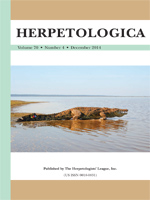Little information on the behavioral ecology and social organization of New Zealand's diplodactylid geckos is available. At least two species may be gregarious and share shelters, but data on the extent and possible function of this behavior are lacking. We examined the spatial distribution patterns of Duvaucel's Geckos in diurnal retreats over the four seasons. We tested whether geckos formed aggregations more often than expected by chance, and investigated whether or not the thermal properties of used shelters, gecko body temperatures and group composition affected aggregation patterns. Duvaucel's Geckos utilized a range of natural structures as diurnal shelters and showed a tendency to aggregate throughout the year (47–71% of individuals). Mixed-sex groups of up to eight individuals, including juveniles, occurred year round. Aggregations never contained more than one adult male and typically consisted of a male–female pair. Shelter-sharing adult males were larger than solitary males. Juveniles sheltered in close association with adults of either sex throughout the study. Shelter thermal properties did not appear to influence aggregative behavior. Aggregation patterns fluctuated seasonally, but the factors affecting these distribution patterns remain unclear. The occurrence of year-round shelter aggregations and frequent male–female and adult–juvenile associations indicate that this species might possess a complex social system. Further research examining the social and genetic relationships between group members, juvenile dispersal rates, and the temporal stability of aggregations is required to confirm the degree of complexity.
BioOne.org will be down briefly for maintenance on 17 December 2024 between 18:00-22:00 Pacific Time US. We apologize for any inconvenience.
How to translate text using browser tools
1 December 2014
Year-Round Mixed-Age Shelter Aggregations in Duvaucel's Geckos (Hoplodactylus duvaucelii)
Manuela Barry,
Uri Shanas,
Dianne H. Brunton
ACCESS THE FULL ARTICLE

Herpetologica
Vol. 70 • No. 4
December 2014
Vol. 70 • No. 4
December 2014
Communal refugia
Diplodactylidae
grouping
New Zealand
sociality




